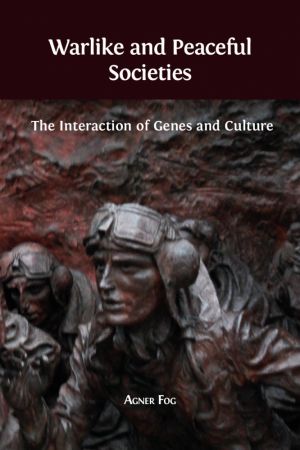Warlike and Peaceful Societies
The Interaction of Genes and Culture
by Agner Fog
DescriptionTable of ContentsDetailsHashtagsReport an issue
In this ambitious and wide-ranging book, Agner Fog presents a ground-breaking new argument that explains the existence of differently organised societies using evolutionary theory. It combines natural sciences and social sciences in a way that is rarely seen.
According to a concept called regality theory, people show a preference for authoritarianism and strong leadership in times of war or collective danger, but desire egalitarian political systems in times of peace and safety. These individual impulses shape the way societies develop and organise themselves, and in this book Agner argues that there is an evolutionary mechanism behind this flexible psychology. Incorporating a wide range of ideas including evolutionary theory, game theory, and ecological theory, Agner analyses the conditions that make us either strident or docile. He tests this theory on data from contemporary and ancient societies, and provides a detailed explanation of the applications of regality theory to issues of war and peace, the rise and fall of empires, the mass media, economic instability, ecological crisis, and much more.
Warlike and Peaceful Societies: The Interaction of Genes and Culture draws on many different fields of both the social sciences and the natural sciences. It will be of interest to academics and students in these fields, including anthropology, political science, history, conflict and peace research, social psychology, and more, as well as the natural sciences, including human biology, human evolution, and ecology. 






Book Description
Are humans violent or peaceful by nature? We are both.In this ambitious and wide-ranging book, Agner Fog presents a ground-breaking new argument that explains the existence of differently organised societies using evolutionary theory. It combines natural sciences and social sciences in a way that is rarely seen.
According to a concept called regality theory, people show a preference for authoritarianism and strong leadership in times of war or collective danger, but desire egalitarian political systems in times of peace and safety. These individual impulses shape the way societies develop and organise themselves, and in this book Agner argues that there is an evolutionary mechanism behind this flexible psychology. Incorporating a wide range of ideas including evolutionary theory, game theory, and ecological theory, Agner analyses the conditions that make us either strident or docile. He tests this theory on data from contemporary and ancient societies, and provides a detailed explanation of the applications of regality theory to issues of war and peace, the rise and fall of empires, the mass media, economic instability, ecological crisis, and much more.
Warlike and Peaceful Societies: The Interaction of Genes and Culture draws on many different fields of both the social sciences and the natural sciences. It will be of interest to academics and students in these fields, including anthropology, political science, history, conflict and peace research, social psychology, and more, as well as the natural sciences, including human biology, human evolution, and ecology.
This open book is licensed under a Creative Commons License (CC BY). You can download Warlike and Peaceful Societies ebook for free in PDF format (25.5 MB).
Table of Contents
Chapter 1
Introduction
Chapter 2
The Theory of Regal and Kungic Cultures
Chapter 3
Contributions from Other Theories
Chapter 4
Different Kinds of War in Human History
Chapter 5
Economic Determinants of Conflict and Fear
Chapter 6
Strategic Uses of Fear
Chapter 7
Regality Theory Applied to Ancient Cultures
Chapter 8
Statistical Testing of Regality Theory
Chapter 9
Discussion and Conclusion
Chapter 10
Bibliography
Chapter 11
Illustrations
Book Details
Title
Warlike and Peaceful Societies
Subject
History
Publisher
Open Book Publishers
Published
2017
Pages
366
Edition
1
Language
English
ISBN13
9781783744039
ISBN10
1783744030
ISBN13 Digital
9781783744053
ISBN10 Digital
1783744057
PDF Size
25.5 MB
License

Related Books

This book presents a comparative analysis of intergroup relations and migrant integration at the neighbourhood level in Europe. Featuring a unique collection of portraits of urban relations between the majority population and immigrant minorities, it examines how relations are structured and evolve in different and increasingly diverse local societ...

This book features various studies on democratization, transformation, political and economic development, and security issues in the Organization for Security and Cooperation in Europe (OSCE) geographical region and beyond. Written by experts and academics in the fields of human rights, security, transformation and development, particularly in pos...

This book covers comprehensive but fundamental principles and concepts of disaster and accident prevention and mitigation, countermeasures, and recovery from disasters or accidents including treatment and care of the victims. Safety and security problems in our society involve not only engineering but also social, legal, economic, cultural, and psy...

This book seeks to foster a multidisciplinary understanding of the ties between faith, financial intermediation, and economic progress by drawing on research across economics, finance, history, philosophy, ethics, theology, public policy, law, and other disciplines. Chapters in this edited volume examine themes as consequential as economic opportun...

This open book discusses how the involvement of citizens into scientific endeavors is expected to contribute to solve the big challenges of our time, such as climate change and the loss of biodiversity, growing inequalities within and between societies, and the sustainability turn. The field of citizen science has been growing in recent decades. Ma...

Existing textbooks on international relations treat history in a cursory fashion and perpetuate a Euro-centric perspective. This textbook pioneers a new approach by historicizing the material traditionally taught in International Relations courses, and by explicitly focusing on non-European cases, debates and issues. The volume is divided into thre...

